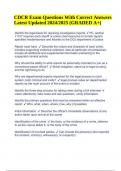Identify the legal basis for requiring investigative reports ✔ PC, section 11107 requires each sheriff or police chief executive to furnish reports specified misdemeanors and felonies to the DOJ department of justice Report must have ✔ Describe the nature and character of each crime, includes supporting evidence collected, note all particular circumstances, include all additional and supplemental information pertaining to the suspected criminal activity Why should the ability to write reports be personally important to you as a correctional peace officer? ✔ Moral obligation, stand up to legal scrutiny, and the right thing to do Why are departmental reports important for the legal process in court system, both criminal and civilly? ✔ legal process relies on departmental reports as the main account of the event or incident Identify the three-step process for taking notes during a full interview ✔ Listen attentively, take notes and ask questions, verify information Identify the primary questions that must be answered within an effective report ✔ Who, what, when, where, how, why (if possible) Initial information ✔ Describe the officer's immediate observations of any action taken upon arrival at the scene identification of the crime ✔ the facts, or the evidence of a crime, referred to as the corpus delicti it, or the body of the crime Identification of involved parties ✔ Can include the person(s) who reported the incident, victim(s), witness(es), or suspect(s) CDCR Exam Questions With Correct Answers Latest Updated 2024/2025 (GRADED A+) Witness/victim statements: ✔ helps place events in their proper sequence, establish the elements of the crime Crime scene specifics ✔ Physical condition of the scene it's self, chronology of events, location of physical evidence Property information: ✔ Such as brand names, model/serial numbers, description like color, unique markings and dimensions, value of stolen item, Location where the item was found or stolen and relationship of the item to the crime/incident CDCR correctional officer actions ✔ Complete report should clearly identify all actions taken by an officer, actions can include Searches conducted, seizures of evidence, arrests, standard procedures such as knock and notice, field show up, Miranda admonishments, use of force, medical attention, safety measures taken, disposition of suspect, methods used to preserve evidence or capture essential information CDCR memorandum ✔ Written for a variety of reasons, including lost staff identification card, observed misconduct by staff or reports of inspection Counseling only RVR ✔ used to document an inmates minor misconduct CDCR form 128-B General chrono ✔ There are three types of this form 1 informational, 2 laudatory, and 3 confidential RVR ✔ use to document inmates misconduct or misbehavior that is not minor, categorized as either serious or administrative CDCR form 837-C staff report and C1 supplement ✔ used to document an incident you observed or were involved in CDCR form 837-C2 Review Notice ✔ use when the information you present on a CDCR form 837-C and C1 is unclear or incomplete Identify the types of information classified as confidential under CCR title 15, Section 3321 ✔ Information, which, if known to the inmate, will endanger the safety of any person, information which would jeopardize the safety of the institution, specific medical or psychological information which, if known to the inmate would be medically or psychologically detrimental to the inmate, Information provided and classified confidential by another governmental agency Identify why inmate counts are conducted per the Department Operations Manual (DOM 52020 ✔ To facilitate inmate control, to facilitate accountability and to expedite inmate movement throughout the institution Identify the primary reasons for conduct inmate counts ✔ Accountability, institutional safety and security, public safety, employee safety and inmate security How many Count does the department should have in a calendar day ✔ At least 4 times Positive count ✔ A physical count of inmates present and seen by the officer Out count ✔ A count of inmates who are away from their assigned housing units at the time of the institution's count Standing count ✔ Inmates stand at their cell door or sit on their assigned bed NOTE! at least one daily count must be standing using the standard of "seeing living and breathing flesh" Negative count ✔ A count of unoccupied beds in a housing unit Picture count ✔ Inmates use their state issued identification card, this is conducted when a positive or negative account does not clear Emergency count ✔ Conducted during a disturbance or emergency, major incidents, riots, escape, natural disaster, or inclement weather Informal count ✔ An officer's physical count and positive identification of all inmates under the direct supervision at work or program assignment




